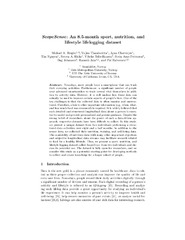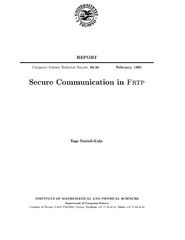Blar i tittel Artikler, rapporter og annet (informatikk)
Viser treff 289-308 av 389
-
Reproduction study using public data of: Development and validation of a deep learning algorithm for detection of diabetic retinopathy in retinal fundus photographs
(Journal article; Tidsskriftartikkel; Peer reviewed, 2019-06-06)We have attempted to reproduce the results in <i>Development and validation of a deep learning algorithm for detection of diabetic retinopathy in retinal fundus photographs</i>, published in JAMA 2016; 316(22), using publicly available data sets. We re-implemented the main method in the original study since the source code is not available. The original study used non-public fundus images from EyePACS ... -
Resilient expansion planning of virtual power plant with an integrated energy system considering reliability criteria of lines and towers
(Journal article; Tidsskriftartikkel; Peer reviewed, 2022-05-25)The portfolio of virtual power plants (VPP) is a flexible system for facilitating a wide range of resources with wide geographical coverage. A VPP can be placed at the intersection of electric power and energy systems by adding heat pumps to the portfolio, thereby accelerating the formation of integrated energy systems. VPPs, while virtual, still rely on a physical network for operations. The power ... -
Review of Extracting Information From the Social Web for Health Personalization
(Journal article; Tidsskriftartikkel; Peer reviewed, 2011)In recent years the Web has come into its own as a social platform where health consumers are actively creating and consuming Web content. Moreover, as the Web matures, consumers are gaining access to personalized applications adapted to their health needs and interests. The creation of personalized Web applications relies on extracted information about the users and the content to personalize. The ... -
Revisiting the ‘Whys’ and ‘Hows’ of the Warm-Up: Are We Asking the Right Questions?
(Journal article; Tidsskriftartikkel; Peer reviewed, 2023-09-02)The warm-up is considered benefcial for increasing body temperature, stimulating the neuromuscular system and overall preparing the athletes for the demands of training sessions and competitions. Even when warm-up–derived benefts are slight and transient, they may still beneft preparedness for subsequent eforts. However, sports training and competition performance are highly afected by contextual ... -
Robust Reasoning for Autonomous Cyber-Physical Systems in Dynamic Environments
(Journal article; Tidsskriftartikkel; Peer reviewed, 2021)Autonomous cyber-physical systems, CPS, in dynamic environments must work impeccably. The cyber-physical systems must handle tasks consistently and trustworthily, i.e., with a robust behavior. Robust systems, in general, require making valid and solid decisions using one or a combination of robust reasoning strategies, algorithms, and robustness analysis. However, in dynamic environments, data can ... -
Role of transfer functions in PSO to select diagnostic attributes for chronic disease prediction: An experimental study
(Journal article; Tidsskriftartikkel; Peer reviewed, 2023-09-22)Particle Swarm Optimization (PSO) is a classic and popularly used meta-heuristic algorithm in many reallife optimization problems due to its less computational complexity and simplicity. The binary version of PSO, known as BPSO, is used to solve binary optimization problems, such as feature selection. Like other meta-heuristic optimization techniques designed on the continuous search space, PSO ... -
Safe Learning for Control using Control Lyapunov Functions and Control Barrier Functions: A Review
(Journal article; Tidsskriftartikkel; Peer reviewed, 2021-10-01)Real-world autonomous systems are often controlled using conventional model-based control methods. But if accurate models of a system are not available, these methods may be unsuitable. For many safety-critical systems, such as robotic systems, a model of the system and a control strategy may be learned using data. When applying learning to safety-critical systems, guaranteeing safety during learning ... -
Satellite communication applied in a distributed application
(Research report; Forskningsrapport, 1994-12)The paper describes the development of a prototype application for access to vital weather information from the Northern Atlantic sea region. The application gives meteorologists access to weather observations measured on sea vessels. Today the available information is very limited. On a daily basis, only 4-5 weather observations in the whole arctic sea-region are conducted. It is therefore suggested ... -
Scalability of Distributed Version Control Systems
(Journal article; Tidsskriftartikkel, 2017-11-26)<p>Distributed version control systems are popular for storing source code, but they are notoriously ill suited for storing large binary files. <p>We report on the results from a set of experiments designed to characterize the behavior of some widely used distributed version control systems with respect to scaling. The experiments measured commit times and repository sizes when storing single files ... -
ScopeSense: An 8.5-Month Sport, Nutrition, and Lifestyle Lifelogging Dataset
(Chapter; Bokkapittel, 2023-03-29)Nowadays, most people have a smartphone that can track their everyday activities. Furthermore, a significant number of people wear advanced smartwatches to track several vital biomarkers in addition to activity data. However, it is still unclear how these data can actually be used to improve certain aspects of people’s lives. One of the key challenges is that the collected data is often massive and ... -
Search-based composition, streaming and playback of video archive content
(Journal article; Tidsskriftartikkel; Peer reviewed, 2011)Locating content in existing video archives is both a time and bandwidth consuming process since users might have to download and manually watch large portions of superfluous videos. In this paper, we present two novel prototypes using an Internet based video composition and streaming system with a keyword-based search interface that collects, converts, analyses, indexes, and ranks video content. ... -
Secure and scalable statistical computation of questionnaire data in R
(Journal article; Tidsskriftartikkel; Peer reviewed, 2016-08-12)Collecting data via a questionnaire and analyzing them while preserving respondents' privacy may increase the number of respondents and the truthfulness of their responses. It may also reduce the systematic differences between respondents and non-respondents. In this paper, we propose a privacy- preserving method for collecting and analyzing survey responses using secure multi-party computation. The ... -
Secure communication in FRTP
(Research report; Forskningsrapport, 1995-02)To ensure privacy, users of the File Repository Transfer Protocol (Frtp) may require that communication partners are properly authenticated. If one partner wants the communication to be crypted, the other must honor the request. This report describes how authentication and privacy are realized. It is shown, by means of an authentication logic, that the protocol achives its goal in this respect. -
Secure Distributed Storage in Peer to Peer Networks
(Lecture; Forelesning; Peer reviewed, 2008-02-07) -
Security in the PASTA project
(Research report; Forskningsrapport, 1997-02-04)This paper presents the system model for the work on security in the Pasta project. We present the objectives of the security effort, the threats we will consider, and those we will not consider. As such, the paper describes the environment which applications must be prepared to face, and still provide users with the desired degree of privacy. -
Selection of Response Reduction Factor Considering Resilience Aspect
(Journal article; Tidsskriftartikkel; Peer reviewed, 2023-02-27)The selection of an adequate response reduction factor (R) in the seismic design of a reinforced concrete building is critical to the building’s seismic response. To construct a robust structure, the R factor should be chosen based on the building’s resilience performance. Since no background was provided for the selection of R factors, the study focuses on the right selection of R factors in relation ... -
A Self-Configuration and Healing Controller To Analyze Misconfigurations of Clusters and IoT Edge Devices
(Conference object; Konferansebidrag, 2023) -
A Self-Configuration Controller To Detect, Identify, and Recover Misconfiguration At IoT Edge Devices and Containerized Cluster System
(Journal article; Tidsskriftartikkel; Peer reviewed, 2023)Securing workloads and information flow against misconfiguration in container-based clusters and edge medical devices is an important part of overall system security. This paper presented a controller that analyzes the misconfiguration, maps the observation to its hidden misconfiguration type, and selects the optimal recovery policy to maximize the performance of defined metrics. In the future, we ... -
Semi-CNN architecture for effective spatio-temporal Learning in action recognition
(Journal article; Tidsskriftartikkel; Peer reviewed, 2020-01-12)This paper introduces a fusion convolutional architecture for efficient learning of spatio-temporal features in video action recognition. Unlike 2D convolutional neural networks (CNNs), 3D CNNs can be applied directly on consecutive frames to extract spatio-temporal features. The aim of this work is to fuse the convolution layers from 2D and 3D CNNs to allow temporal encoding with fewer parameters ... -
Separating mobility from mobile agents
(Research report; Forskningsrapport, 2001-01-16)In this paper we argue that the traditional model of a mobile agent provides a poor programming structure. We base our argument on our experience since 1993 in building distributed applications and mobile agent platforms. We have observed that every distributed applications contain three distinct aspects, which we call function, mobility and management. Separating an application into these three ...


 English
English norsk
norsk


















